34 Types of Eggs to Enhance Your Favorite Meals
Author: Anne Cowart | Editor: Omar Alonso
Review & Research: Jen Worst & Chris Miller

There are many different ways to classify the different types of eggs to eat. If you look at a carton, you will see plenty of information these days and some logos. It’s important to understand what they mean because the condition of the animals during breeding season bears weight on the nutritional value of their eggs.
In this piece, we will give you a peek into all of the different kinds of eggs. You'll learn about the grades of eggs, the size classifications, the labels associated with their features, and which animals produce eggs we can enjoy.
3 Types of Eggs by Grade
When you are buying a carton of eggs, you see that they are divided into grades which can be found on the label. That’s one way to look at the different types of eggs in the market. These grades are given by the USDA to let you know about the quality of the product you are buying.
The grade takes the appearance, texture and behavior of the eggs when they are cooked. This is what each of the grades means.
Grade AA

This is the best quality of eggs on the market. You know that the moment you look at them because their appearance is perfect. When you crack them open, you will see that there is a thick egg white and a round and firm yolk inside.
You can use these eggs for anything, but if you plan to cook in the shell, fry or poach them, grade AA eggs are a perfect choice.
Grade A
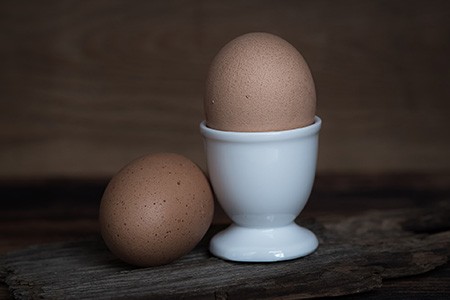
This is the second-best quality of eggs on the market. When you crack them open, you will see that the area covered is moderate. There is a pretty thick egg white and a firm yolk inside.
These can also be used for any purpose and they are great for the purposes mentioned for grade AA. These are the most commonly found eggs in stores.
Grade B

This is the next category of quality among the egg types. These eggs also cover a wide space but the egg white inside is a bit watery and weak in appearance. The yolk is also a bit flat. You can use them to make scrambled eggs in the right types of pans. They are also an okay choice if you want to add them to a dish along with other ingredients.
6 Types of Eggs by Size
If you’re looking for a classification based on size, well, in the US eggs are available in six different sizes. These sizes are determined based on the weight of the egg without the weight of the shell.
You will find medium, large and extra-large eggs in most stores. Here are the details of their individual weight.
- Peewee: 15 ounces
- Small: 18 ounces
- Medium: 21 ounces
- Large: 24 ounces
- Extra-Large: 27 ounces
- Jumbo: 30 ounces
You might have to take a special trip to find the jumbo or peewee sizes. I've never seen them in any standard grocery store on the shelves.
16 Types of Eggs by Label
There are many different labels in the market and that can get very confusing. This is perhaps the longest list of classifications for eggs. Take a look.
White Eggs (Standard)
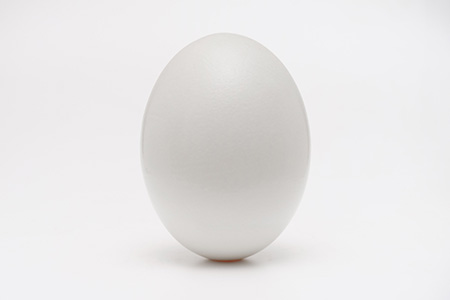
Chicken eggs come in different colors from tones of blue to pink to brown and white. You may also find green eggs on the market and those aren’t toys. But white and brown are the most common ones.
White eggs are laid by white hens that are grown in conventional systems. They have been a standard for a long time, but some industries are now moving away from them.
Brown Eggs (Standard)

A lot of people tend to think that brown eggs, like brown rice, are supposed to be healthier, but that’s not true. These eggs are brown because they come from different breeds.
They are more expensive than white eggs because these breeds of chickens are bigger in size and it’s costlier to raise them. These hens also come from conventional systems.
Nest-Laid or Enriched Eggs

These eggs are from hens that were brought up in furnished housing systems. That means they have enough space for the hens to walk around the property. The hens also get a few enrichments like perches, boxes for nesting, dust baths and scratch pads, which allow them to express themselves naturally.
Cage-Free Eggs

These types of eggs are from hens that are allowed to walk around the room or a building. It might also be a barn or an aviary. Sometimes, it’s an open area that has perches and nesting spaces. Cage-free eggs are also referred to as free-range eggs, which we'll talk more about below, but are not the same.
Free-Range Eggs

These eggs are from hens that are grown in a housing system like an aviary or a barn. These eggs are pretty much like cage-free eggs except the hens are allowed outside when the weather cooperates. The hens’ access to the outdoors is not negotiable.
Sometimes, these eggs are also called organic eggs. The hens are given food that is certified to be organic. So, their diet will have food that was grown without the help of commercial fertilizers, pesticides or herbicides.
There is a symbol on the carton that will tell you that the eggs are organic. Cage-free eggs can also be organic.
Certified Humane
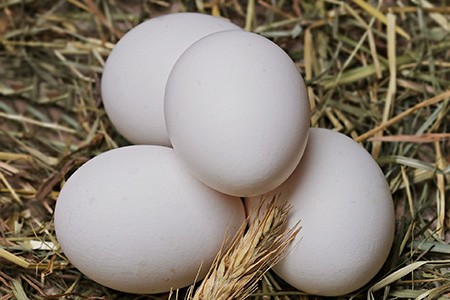
These egg types are from hens that were grown in housing systems that are humane. Who decides that? The Humane Farm Animal Care Organization has specific conditions that a housing system must meet to be certified as humane.
Sometimes, you will find that the certification is from the American Humane Association. In that case, the conditions have been audited and checked by a third-party under a program by the AHA and been certified humane.
Vitamin-Enhanced Eggs

These are eggs laid by hens that have been given food that was nutritionally enhanced. That means their diet has more of some vitamins like D or E. because of that, these eggs are richer in those vitamins.
Omega-3 Eggs

All types of eggs that are laid by hens or other animals that were given 10 to 20 percent more flax will be richer in omega-3 fatty acids.
Vegetarian Eggs

These eggs are from hens that only ate food that was made with plant-based ingredients. Essentially, vegetarian eggs were laid by vegetarian hens.
Pasture-Raised Eggs
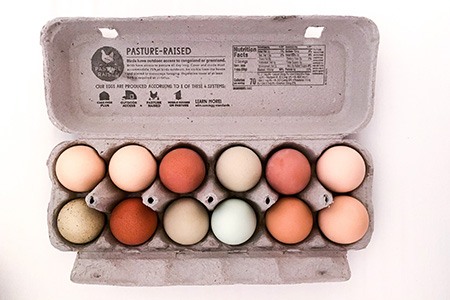
These are eggs that came from hens that were grown on a maintained pasture. They were free to roam around and forage in that area.
Processed Eggs

These types of eggs are usually used to make certain egg products. The eggs used to make these products were broken using special machines, following which they were pasturized. These products also have ingredients like preservatives added to them. Your egg whites might fall under this category.
Pasteurized Eggs

These are eggs that have been subjected to the process of pasteurization by heating them to a certain temperature. The process makes sure that pathogens, if any, are destroyed in the process.
Antibiotic-Free Eggs
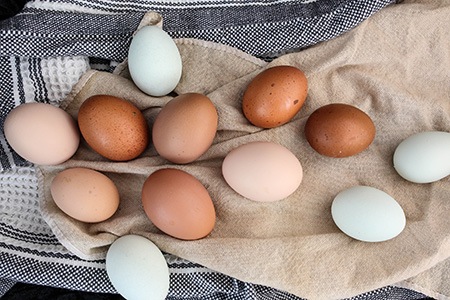
These are kinds of eggs that don’t have any residue of antibiotics. But if the hen was given antibiotics, the eggs can’t have this label even though they might not have antibiotic residue.
Araucana Eggs

These eggs come from chickens that are originally from the Araucana region in South America. They are blue-green in color and their nutritional value is the same as standard white and brown eggs. Contrary to popular belief, these eggs have high levels of cholesterol.
Commercial Eggs

This is the term for eggs that have been laid by hens that were inhumanely confined to cages where they can barely move. These are also referred to as factory-farmed eggs and unless there are other labels like cage-free or certified humane, these hens have had a pretty tough life.
Fertile Eggs

The typical egg isn’t fertile, which means the hen never came in touch with a rooster. That means the egg will not hatch to develop a chick.
But some people believe that fertile eggs have more nutritional value, which is why some producers sell these different kinds of eggs. That’s a myth, though, and that goes for all types of eggs. There’s no such advantage, nutritional or otherwise.
9 Types of Eggs by Animal
If you are looking for different types of animal eggs, well, there’s plenty of choice here too. Since you know more than enough about eggs that come from hens, let’s get that out of the way fast and then look at the others.
We won't mention them because they're so hard to find, but if you're really diligent you can pursue pigeon eggs and gull eggs. And of course there's caviar (fish eggs), too.
Chicken Eggs
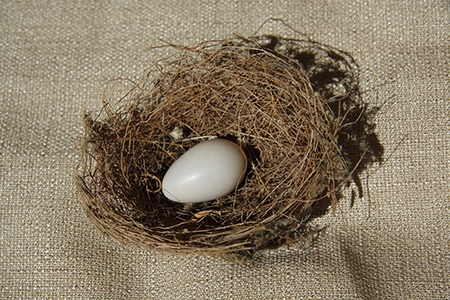
As we all know, chicken eggs are the most prevalently farmed and available to us in grocery stores. People will even have their own family of chickens at home to enjoy their own eggs, which is a fairly popular hobby for those seeking to be self-sufficient.
Duck Eggs

These egg types look like eggs from a hen but are bigger in size. They come in the same sizes as chicken eggs, but this one has a more transparent egg white and doesn’t have the yellow tone that hen’s eggs do.
These eggs are also rich in flavor and protein compared to chicken eggs. But their cholesterol and fat content is also higher than chicken eggs. Interestingly, you will see the egg white turn blue and the yolk turn orange-red when you boil the egg.
Goose Eggs
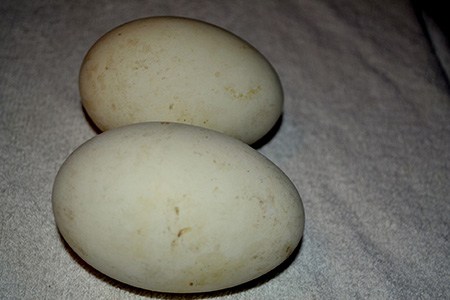
These types of eggs are at least double the size of the eggs that come from hens. Sometimes they are 4 to 5 times bigger. They do taste like a lot of eggs, but people often call it as being rich in flavor. You can use them for anything that you would use chicken eggs for, except you will need fewer eggs.
Turkey Eggs
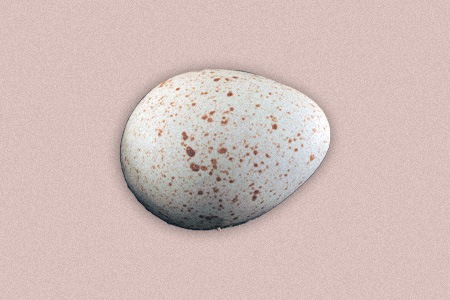
These eggs are also bigger than eggs coming from hens. You are unlikely to find them in stores, so if you can go to a farmer that raises turkeys, you can try your luck.
Quail Eggs

These are the size of the smallest chicken egg, which is the peewee size. They are quite popular in Chinese and Japanese cuisines. So, keep an eye out for that little detail when going on the lookout for these.
Pheasant Eggs

Pheasant eggs have a light brown and olive green hue to their shells and have a very rich flavor to them. They're not as big as your standard chicken egg, coming in maybe half the size, so double the count if you're using them in recipes.
People who can find them at local farms or farmers markets enjoy using them for quiches in their various types of ovens, omelets, sandwiches, and even scrambling them. You can raise your own pheasants if you find you absolutely must have access to these different types of animal eggs.
Emu Eggs

These are becoming quite popular and they come from different breeders. They have a mild taste and emus can produce 20-50 eggs every season. These shells can be found in a color range from teal to dark green. And each emu egg is equivalent to 10-12 hen eggs.
Ostrich Eggs
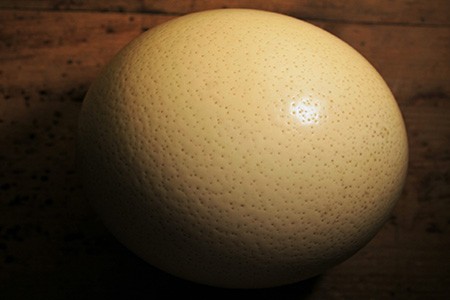
Depending on where you live, you can get ahold of ostrich eggs, which are relatively gigantic. It's said that it would take 20 chicken eggs to produce as much food as one ostrich egg. As you can imagine, this is an easy way to make a giant bowl of scrambled eggs. They'll cost around $30 dollars each if you can find a farmer that will provide them to you. Lay them out on fluffy types of towels when preparing to cook them so you don't have any accidents!
Crocodile Eggs

Yes, for around $25 dollars you can enjoy a tasty crocodile egg. They're as nutritious as any other of the different types of animal eggs on the list, but the interesting thing is they have no yolk. They only feature the white inside. They have a fishy taste to them, so be aware before you spend the time finding one.
Types of Eggs for Every Taste
Now that you have a comprehensive understanding of the different types of eggs to eat, you might want to look around and find out more about how these details affect the egg you are consuming and what it means for your overall health.




